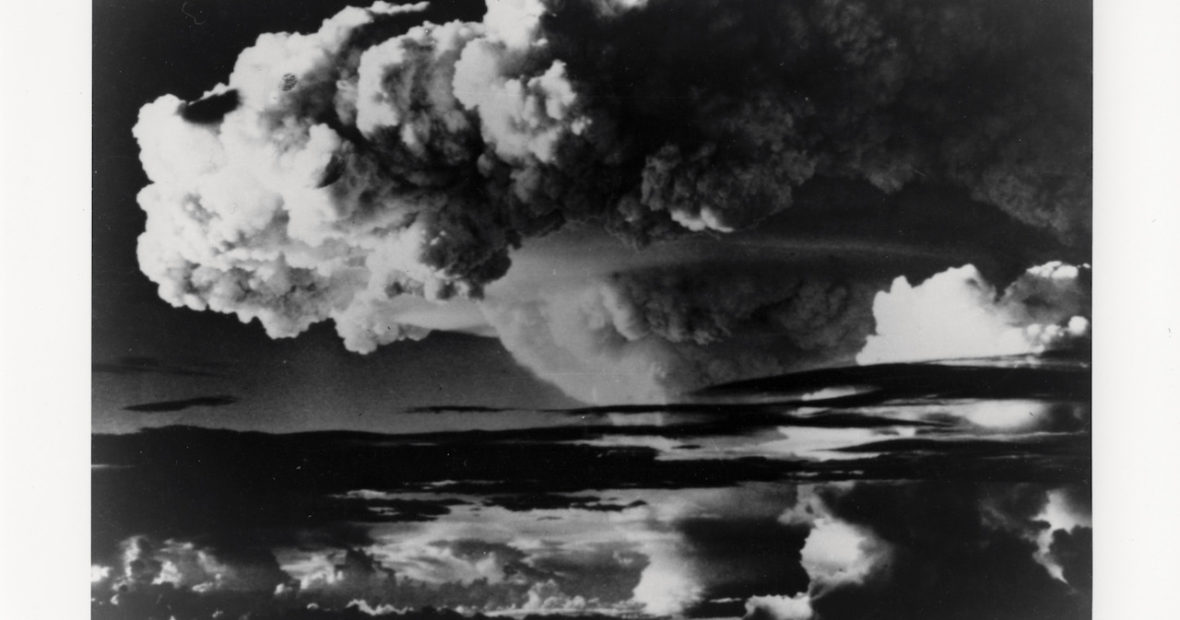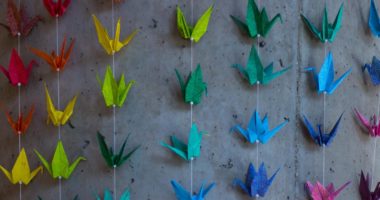***
It was a very hot and humid day when I arrived at the Hiroshima Peace Memorial Museum this past August. Despite the air being so sticky, it was clear that this was a place where people had come to calmly reflect. The yearning for peace was strong, perceptible even, in the manner that visitors thoughtfully laid down their flowers and placed their carefully folded cranes at the foot of monuments.
With Japan being the only country to have experienced atomic bombings and with thousands of bomb survivors, or ‘Hibakusha’, still wearing the scars of that horror on their bodies and in their minds, the history and name of Hiroshima is well-known across the world.
The ICRC’s Dr Marcel Junod was the first foreign doctor to reach Hiroshima after the bomb on 6 August 1945 and to treat some of the victims. In his journal he described
a site totally unlike anything we had ever seen before. The centre of the city was a sort of white patch, flattened and smooth like the palm of a hand. Nothing remained.
When writing about his visit to the emergency hospital, he added that
several patients are suffering from the delayed effects of radioactivity with multiple haemorrhages. They need small blood transfusions at regular intervals; but there are no donors, no doctors to determine the compatibility of the blood groups; consequently, there is no treatment.
Following in the footsteps of Dr Junod, standing there in Hiroshima, it is almost too hard to get one’s head around the significance and the extent of the suffering that occurred. The Museum, however, does an excellent job of illustrating the tragedy and evoking hope, with its poignant displays and sobering testimonies providing the evidence, facts and figures in a way that powerfully moved me.

As many will know, the atomic bomb dropped on Hiroshima created a fireball that destroyed 13 square kilometres of the city. The facts describing the death and devastation that ensued are almost inconceivable. Around 63% of the buildings in Hiroshima were completely destroyed and many more were damaged. Estimates of total deaths in Hiroshima have generally ranged between 100,000 and 180,000, out of a population of 350,000. In Hiroshima and Nagasaki combined, approximately 340,000 people died immediately and within five years of the bombs being dropped.
But aside from the facts, what touched me most at the Museum were the small gestures. The heartbreak of seeing the twisted remains of a child’s tricycle and wondering that if the impact of the explosion on the metal was so heavy, what would it have done to the small compact body of the child. The clothes and school uniforms of survivors—carefully laid out—clearly marked with patterns of blood and burns. Other objects of everyday life—a lunchbox, a watch and a water bottle—in tatters or warped beyond recognition.
The Treaty on the Prohibition of Nuclear Weapons recognizes these catastrophic humanitarian consequences of nuclear weapons and their incompatibility with international humanitarian law. Acknowledging that the use of nuclear weapons is not limited to the immediate effects, it also requires assistance for victims of nuclear weapons use and testing, and for environmental remediation. In fact, 190,000 Hibakusha are still alive, as well as 200,000 ‘second generation’ survivors. Both continue to suffer from increased incidences of leukaemia and other cancers. Many have psychological instability, including post-traumatic stress disorder.
The Treaty also provides a comprehensive prohibition of nuclear weapons and a pathway for their elimination. Although it will not make nuclear weapons immediately disappear, it reinforces the stigma against their use and supports commitments to nuclear risk reduction. In particular, it strengthens the commitments found in Article VI of the 1970 Treaty on the Non-Proliferation of Nuclear Weapons, which remains a cornerstone of disarmament efforts. The Treaty also serves as a clear disincentive for proliferation—an especially important aspect today, with rising international and regional tensions, consequently increasing the risk of nuclear weapons use.
While the Treaty is not yet in force, many of the States who have signed it this past year, and the many others who voted to adopt it, are currently going through their national ratification procedures. These processes naturally take time, but I am confident that the Treaty will reach the 50 ratifications necessary for it to enter into force in the near future.
My visit to the Hiroshima Peace Memorial Museum will stay with me throughout our efforts to urge all States to join the treaty. We first called for nuclear weapons to be abolished in September 1945, shortly after the devastation and unspeakable suffering that Dr Junod and our other colleagues witnessed in Hiroshima and Nagasaki. The ICRC and the broader Red Cross and Red Crescent Movement repeated these calls throughout the Cold War and have continued to do so ever since. Next week on the International Day for the Total Elimination of Nuclear Weapons, another signing ceremony will take place during the high-level segment of the UN General Assembly, at which the ICRC President Peter Maurer will speak. I take this opportunity to encourage all States that have not yet done so to join the Treaty on this occasion.
The power of the museum served to remind me of the people beyond the Treaty and behind the statistics—men, women and children going about their daily lives—who were destroyed by a single use of this deadly and unacceptable weapon. Yet, it also stirred within me a sense of hope, for a common belief in the intrinsic worth of humanity, the dignity of human beings and a world free from the horrors of nuclear weapons.
***
For further information
- New ICRC campaign page on nuclear weapons
- ICRC President, Peter Maurer’s statement 23 April 2018: Nuclear Weapons: Averting a global catastrophe
- ICRC legal factsheet on theTreaty on the Prohibition of Nuclear Weapons, 24 April 2018
- International Review of the Red Cross: The human cost of nuclear weapons, 2016
Blog posts on nuclear weapons
- The prohibition of nuclear weapons: Assisting victims and remediating the environment, Elizabeth Minor, 10 October 2017
- Majority of governments vote for negotiations to prohibit nuclear weapons, Ellen Policinski,29 August 2016
- Nuclear weapons: Rising in defence of humanity, Ellen Policinski & Vincent Bernard, 27 July 2016
- Nuclear weapons: 20 years since the ICJ advisory opinion and still difficult to reconcile with international humanitarian law, Louis G. Maresca, 8 July 2016






It is my profound expectation that State parties to the Treaty act fast in the interest of humanity to ratify same so as to give humanity an air of positive existence.
Thank you very much Helen for sharing your thoughtful reflections.
Indeed the small gestures were the most powerful ones also in the Nagasaki Atomic Bomb museum. What moved me the most was the shadows of people imprinted on the walls, on buildings and sidewalks. A stark reminder of one a darkest time in human history.
It is now crucial to make the Treaty on the prohibition of nuclear weapons come to life.
By signing and ratifying the Treaty, states are sending a clear message that any use, threat of use or possession of these weapons is unacceptable in humanitarian, moral, and now legal terms. It will our message during the UN General Assembly, in each and every conference rooms!
Thank you very much Helen for sharing your thoughtful reflections.
What moved me the most at the Nagasaki Atomic Bomb Museum were the shadows of people imprinted in the walls, buildings and sidewalks. A stark reminder of the darkest movement in the history of humanity.
Now we have a Treaty on the prohibition of nuclear weapons.
By signing and ratifying the Treaty, states are sending a clear message that any use, threat of use or possession of these weapons is unacceptable in humanitarian, moral, and now legal terms. It will our message during the UN General Assembly, in each and every conference rooms!
You can feel the pinch of such terrific tragedy to fellow humans by reading this insight but also the pictures displayed at the museum. Indeed the Treaty prohibiting the use of nuclear weapons is inevitable especially now in this more globalized era. We have obligation to save humanity and not embracing misuse of technology.
Thank you for sharing , now that there is a treaty on the Prohibition of Nuclear weapons we consider it as a great step . Hoping that the treaty will reach the 50 ratafications necessary for it to enter into force in the near future .